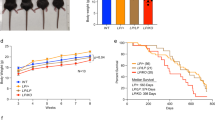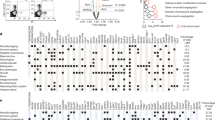Abstract
Bloom's syndrome (BS) is a rare human genetic disorder characterized by mutations within the BLM gene whose primary effects are excessive chromosome breakaoge and increased rates of sister chromatide interchange in somatic cells. We report the characterization of a murine protein (mBLM), highly related to the product of the human BLM gene. This protein exhibits an ATP-dependent DNA-helicase activity that unwinds DNA in a 3′–5′ direction. Single aminoacid substitutions found in BS cells, abolish both ATPase and helicase activities of this protein, indicating that defects in these BLM functions may be primarily responsible for BS establishment. These results provide the first evidence suggesting that the enzymatic activities of the BLM product are implicated in the upholding of genomic integrity.
This is a preview of subscription content, access via your institution
Access options
Subscribe to this journal
Receive 50 print issues and online access
$259.00 per year
only $5.18 per issue
Buy this article
- Purchase on Springer Link
- Instant access to full article PDF
Prices may be subject to local taxes which are calculated during checkout
Similar content being viewed by others
Author information
Authors and Affiliations
Rights and permissions
About this article
Cite this article
Bahr, A., De Graeve, F., Kedinger, C. et al. Point mutations causing Bloom's syndrome abolish ATPase and DNA helicase activities of the BLM protein. Oncogene 17, 2565–2571 (1998). https://doi.org/10.1038/sj.onc.1202389
Received:
Revised:
Accepted:
Published:
Issue Date:
DOI: https://doi.org/10.1038/sj.onc.1202389
Keywords
This article is cited by
-
Investigating the pathogenic SNPs in BLM helicase and their biological consequences by computational approach
Scientific Reports (2020)
-
Homozygosity for the WRN Helicase-Inactivating Variant, R834C, does not confer a Werner syndrome clinical phenotype
Scientific Reports (2017)
-
A novel frameshift mutation in BLM gene associated with high sister chromatid exchanges (SCE) in heterozygous family members
Molecular Biology Reports (2014)
-
On BLM helicase in recombination-mediated telomere maintenance
Molecular Biology Reports (2013)
-
RecQ helicases; at the crossroad of genome replication, repair, and recombination
Molecular Biology Reports (2012)



